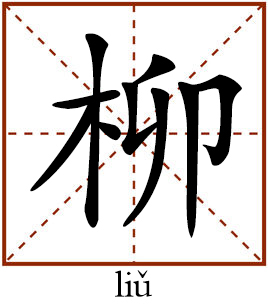Willows literary symbol for sorrow of separation

The character for the willow tree is a homophone of the character liu, which means asking a person to stay when bidding farewell. Thus willows symbolize the sorrow of separation in Chinese culture.

The character for the willow tree is a homophone of the character liu, which means asking a person to stay when bidding farewell. Thus it symbolizes the sorrow of separation.
Evocative of numerous melancholy emotions, the willow is a commonly used symbol in ancient Chinese literature. The first images that the willows present to us are their swaying branches and flying catkins in spring, which, for Chinese, embody the sorrows of being separated from loved ones, whether they are friends, lovers or other family members.
The word for willow is a homophone of the Chinese character “liu,” which means “to stay.” The behavior of breaking off a willow branch and sending it to those departing for a long journey then became a gesture of asking them to stay, a way to express their missing feelings. This custom, dating back to the Han Dynasty, was particularly popular in the Tang Dynasty. The saying at that time, for example “All the willow branches have been broken off” or “Why so frequently pull down and break off a willow branch?” were vivid examples of this custom.
The slim willow branch is a symbol of the fragile feelings and reluctance to be separated from loved ones. A famous chapter in the Book of Songs gives us endless tastes of this picture. The chapter Picking Vetches goes “When I set out so long ago, fresh and green was the willow. When now homeward I go, falling heavily was the snow.” The poem tells the story of a soldier reluctant to leave his hometown after being enlisted in the army. It was in the spring when he left his hometown. The willows were fresh, swaying and dancing as if they were reluctant to let him go. Tears trickling down his cheeks, he realized that he could not bear to leave his home.
This song portrayed the sorrow of a poet who was reluctant to leave his hometown. Ever since then, the swaying image of a willow tree has been frequently and harmoniously associated with the sorrow of parting in literary works.
Accordingly, a piece of ancient bamboo flute music named “Breaking Willow Branches” was also frequently used by poets to express their parting sorrows and grief. When a poet hears this bamboo flute music, it naturally stirs his homesickness.
One of the greatest poets in the Tang Dynasty, Li Bai (701-762), wrote a well-known poem about this. It goes “From whose house comes the song of the jade flute unseen? It fills the town of Luoyang, spread by wind of spring. Tonight I hear the farewell song of Willow Green. To whom the tune will not nostalgic feeling bring?”
A person who has long stayed away from their hometown was usually sensitive and emotional. The falling night stirred a sense of homesickness, let alone when accompanied by flute music named “Willow-breaking.”
All things revive when spring warms the world. Sensitive to the seasonal changes of the world, the poets were amazed at the return of spring when they noticed the light yellow willow branches.
A poem by He Zhizhang (c.659-c.744) in the Tang Dynasty best described the image of willow trees in spring. It goes “The slender tree is dressed in emerald all about; A thousand branches droop like fringes made of jade. But you know by whom these slim leaves are cut out? The wind of early spring is sharp as a scissor blade.” This poem, describing the willow, pays homage to spring as it brings vitality to the world.
Xue Wensu is from the Shanxi Management Vocational College.
(edited by CHEN ALONG)
